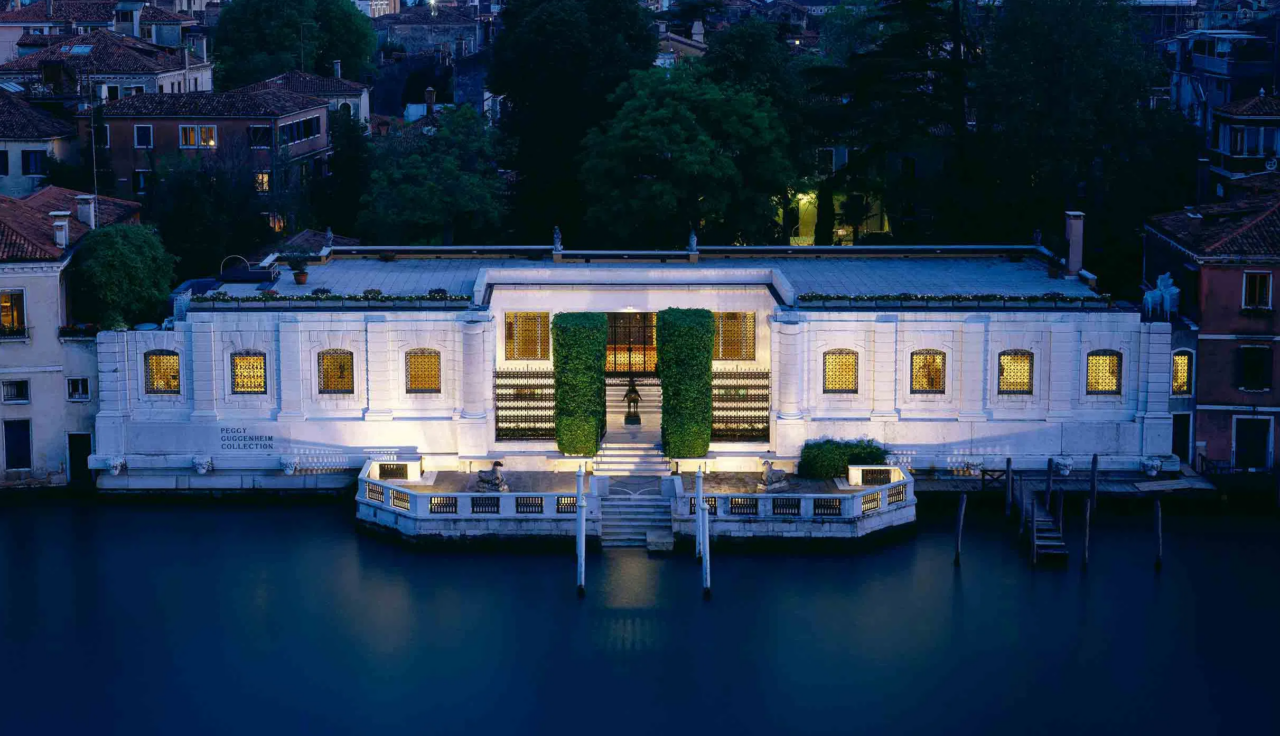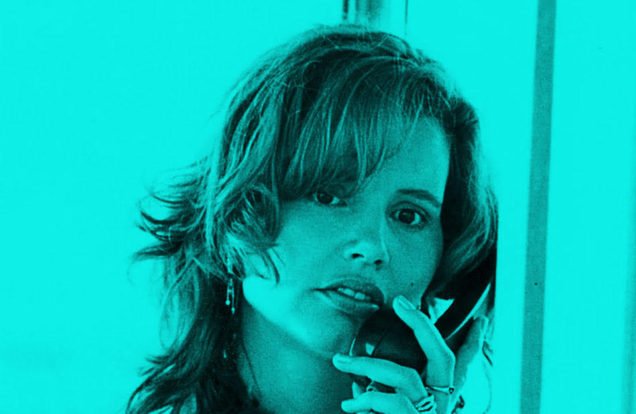ART, LOVE, NYMPHOMANIA.
The Sensual Life of Peggy Guggenheim


The first time I visited the Peggy Guggenheim Museum in Venice, I found myself more intrigued by the heiress who had called the 18th century Palazzo Venier dei Leoni home for thirty years than by the astonishing collection of modern art hanging on the walls. Sure, there was the Marino Marini bronze, The Angel and the City, depicting a horse and its aroused rider whose erect phallus saluted visitors at the palazzo’s Grand Canal entrance, and the other 325 works by such modern masters as Picasso, Miro, Calder, Dali, Giacometti, Kandinsky, Rothko, and de Kooning. But it was the collection of stories starring the enfant terrible herself that piqued my interest.
Many museum exhibitions, especially the permanent collections, seem impersonal; curated to draw crowds instead of emotional connections. The Peggy Guggenheim Collection reflects the Boho Queen’s personal taste, though she’d be the first to admit she didn’t know a fig about art. (This, despite being the niece of Solomon R. Guggenheim whose Frank Lloyd Wright-designed museum in New York City opened in 1959.)

According to a 2009 profile in The Guardian, “She received her most thorough grounding in modern art when she spent a night and a day in bed with Samuel Beckett, interrupted only when she demanded he go out and find some champagne.“ She later confessed, “I didn’t know anything about the price of things” and therefore wound up buying art for the price people quoted her.
However, Peggy knew what she liked, and the only thing she liked more than art was sex. A self-professed nymphomaniac, she claimed to have had more than 400 lovers (although rumor has it the actual number is closer to 1,000). Not bad for an ordinary-looking woman. Famous for her nose, which has been described as potato-like, and her money, she lived a life so full it took two autobiographies, Out of this Century and Confessions of an Art Addict, to catalog all of it. Unafraid to pull back the curtain on her sexual adventures, when Out of this Century was first published in 1946, members of her family found it so scandalous that they not only labeled it Out of her Mind, they tried (unsuccessfully) to purchase every copy of the book. Thank God they didn’t. The book, like Diana Vreeland’s DV, is one of the most frank and enjoyable autobiographies by trailblazing women you’ll ever read.
The second of three daughters born to Benjamin and Florette Guggenheim, descendants of the Our Crowd Jewish community that emigrated to New York in the early 1900s, Peggy, neé Marguerite, grew up in grand style in a limestone mansion on East 72nd Street. Her mother, whose family made their fortune in retail stores before moving into precious metals and ultimately banking and finance, was an eccentric, known to repeat everything she said three times. Her philandering father made a fortune smelting metals. After he died on the Titanic, with his mistress in tow, Peggy spent the rest of her life looking for a man to replace him. Like her kindred spirits, the American Tobacco Company heiress, Doris Duke, and Barbara Hutton, heir to the Woolworth fortune, Peggy was born into a world of luxury, but unlike the ‘Goldust Twins’, as the other two were known, she never fell victim to her lovers’ ambitions. She capitalized on them.
Feeling suffocated by a repressive home environment, she fled to Paris in the 1920s where she took up with members of the Lost Generation including lesbian writer Djuna Barnes, artists Man Ray, Jean Cocteau, Constantin Brancusi and Marcel Duchamp, who she later said “taught me everything I know about modern art.” Her liberated libido was as robust as any man’s, and she became known for her wild and frequent liaisons. When asked how many husbands she had had, she is said to have replied, “You mean my own, or someone else’s?”
Art for Peggy was an aphrodisiac. Among her cadre of lovers were Yves Tanguy, Duchamp, playwright Samuel Beckett and composer John Cage. She married twice, first to artist Laurence Vail in 1922. The couple, whose relationship was drama-filled and physically abusive, had two children, a son, Sinbad and a daughter, Pegeen. They divorced in 1928. She married again in 1941, this time to surrealist painter, Max Ernst “Because he’s so beautiful and because he’s so famous.” In between her marriages, she fell in love with John Holms, a writer and severe alcoholic who died in 1934, and Douglas Garman, also a writer, with whom she stayed for many years.

Not all of her discoveries wound up in her bed. Jackson Pollock, whom she met when he was working as a carpenter at The Museum of Non-Objective Painting (forerunner to The Guggenheim), said that he would only make love to her if she was covered up with towels. In response, she claimed he drank too much for her taste. Whatever the reason for the chasteness of their relationship, documentarian, Lisa Immordino Vreeland, whose film Peggy Guggenheim: Art Addict was released in 2015, maintains that Pollack is the one artist Peggy was most proud of discovering. “She considered him her spiritual offspring. He needed her support, and this allowed him to create with real freedom. This mindset of discovering this unproven group of artists would ultimately be her most important legacy.”

In 1938, flush with the inheritance from her mother’s death, she opened the Guggenheim-Jeune gallery in London. The opening show featuring 30 drawings by Jean Cocteau was a hit, and soon she was exhibiting the works of Kandinsky, Calder and Henry Moore. In the pre-war milieu, the gallery was a critical success but a financial failure. Peggy began collaborating with art historian Harold Reade on starting a Museum of Modern Art. She closed the gallery and armed with a list of artworks they hoped to secure for the museum, she travelled back to Paris, determined to buy a painting a day.

Her timing was incredible. In advance of the Nazi’s invasion, many artists and dealers were eager to sell their work and leave France. In the days leading up to the occupation of Paris, she scoured the ateliers and with just $40,000, was able to purchase works by Picasso, Ernst, Magritte, Man Ray, Dali, Klee, Miro and Chagall. She devised a scheme to ship the works back to America as household items, and packed them along with dishes and linens. With her masterpieces safely en route via steamship, she returned to New York with future husband, Max Ernst.
Once back in the city she opened a new gallery, Art of This Century, with sections devoted to Cubist, Surrealist and Kinetic art. To show her unbiased dedication to the various forms of art she was exhibiting, she wore mismatching earrings – one by Calder and the other by Yves Tanguy – to the gallery’s opening.
It seems strangely appropriate that after receiving resounding negative feedback on the post-war publication of her autobiography, Guggenheim wound up settling in Venice. Italy, after all, was not only rich in history, both of art and otherwise, it had been home to the Medici’s, the Florentine clan that fostered and inspired the Renaissance. Perhaps no other family comes close to leaving its mark on the world of art except the Guggenheims.
In Venice, she became an instant celebrity, navigating the archipelago in her private gondola, her beloved Lhasa Apsos in her lap, taking in the view through her signature butterfly sunglasses. Her palazzo became the nexus for visiting artists and writers and in 1951 she opened her home and her collection, including many paintings by her daughter Pegeen, to the public.

Guggenheim, who often referred to the works in her collection as her children and her 14 Lhasa Apsos as her babies, was traveling in Mexico in 1967 when she got the tragic news that her 41-year-old daughter Pegeen, had died of an alleged barbiturate overdose. Lamented Guggenheim, “My darling Pegeen, who was not only a daughter, but also a friend and sister to me.”
Which takes me back to the first time I visited the Palazzo Venier dei Leoni. I now know why I was so intrigued by Peggy Guggenheim. Beyond the sex, the wild parties with bad wine and the terrible food she was known to have served, beyond the masterpieces and the money, was a strange and complex woman who left a legacy for the world to enjoy. Perhaps the most haunting image from that trip was the stone marker in the garden indicating where the ashes of her 14 dogs were buried. The slab is engraved: “Here lie my babies” along with their birth and death dates and their names, which included Madam Butterfly, Emily, Sir Herbert, Cappuccino and strangely enough, Pegeen. When Peggy, herself died at the age of 81 in 1979, her ashes were buried in the garden next to those of her beloved “babies”. Her actual baby, Pegeen, is buried some 525 miles away from her mother in the Pére Lachaise Cemetery in Paris.



